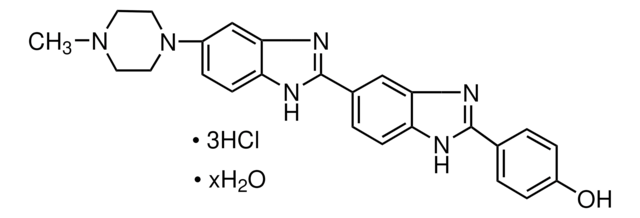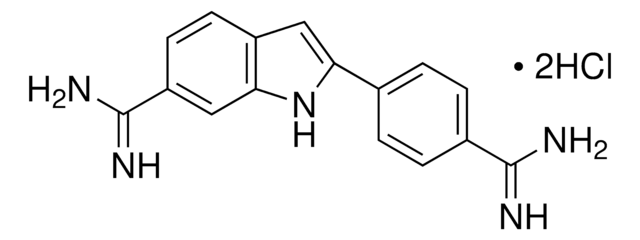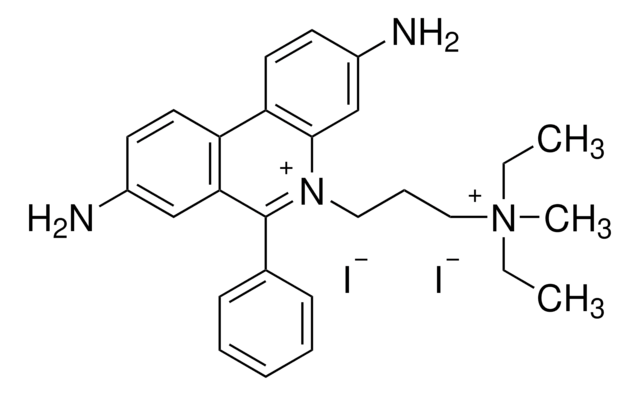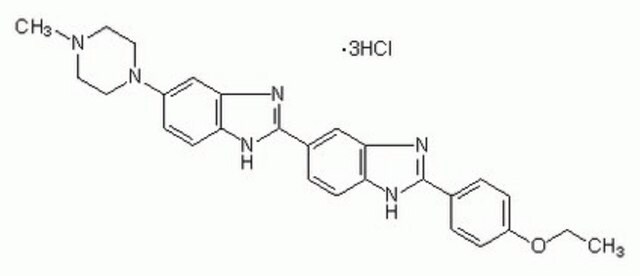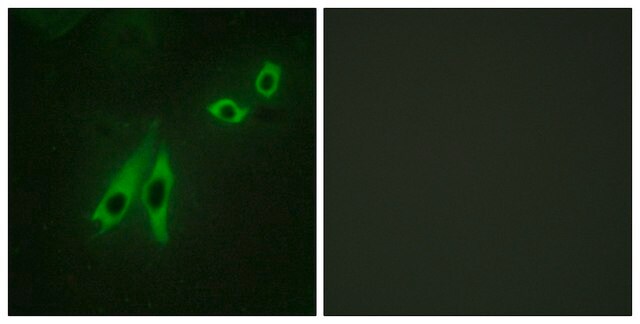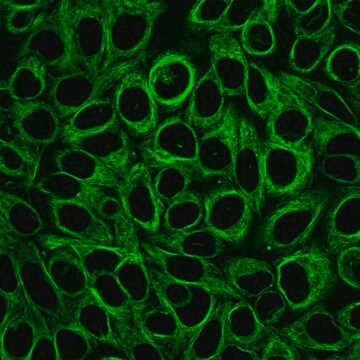추천 제품
Quality Level
분석
≥98.0% (HPLC)
양식
liquid
농도
1 mg/mL in H2O
solubility
DMF: soluble
H2O: soluble
형광
λex 355 nm; λem 465 nm in TE buffer; DNA
저장 온도
2-8°C
SMILES string
Cl.Cl.Cl.CN1CCN(CC1)c2ccc3[nH]c(nc3c2)-c4ccc5nc([nH]c5c4)-c6ccc(O)cc6
InChI
1S/C25H24N6O.3ClH/c1-30-10-12-31(13-11-30)18-5-9-21-23(15-18)29-25(27-21)17-4-8-20-22(14-17)28-24(26-20)16-2-6-19(32)7-3-16;;;/h2-9,14-15,32H,10-13H2,1H3,(H,26,28)(H,27,29);3*1H
InChI key
SMNPLAKEGAEPJD-UHFFFAOYSA-N
일반 설명
Hoechst 33258, also known as bisbenzimide, is a fluorescent blue dye. It is categorized as a chromosomal stain that binds to the minor groove of the DNA double helix recognizing a run of four A-T base pairs.
애플리케이션
Hoechst 33258 is used to estimate DNA concentration in samples by fluorometry which is better than spectrophotometry, allowing the determination of nanogram quantities of DNA. Also, Hoechst 33258 is suitable to detect mycoplasma contamination in cell cultures due to its high fluorescence ability.
Storage Class Code
10 - Combustible liquids
Flash Point (°F)
Not applicable
Flash Point (°C)
Not applicable
이미 열람한 고객
Cornelia Fritsch et al.
PLoS genetics, 15(7), e1008269-e1008269 (2019-07-13)
Development of eye tissue is initiated by a conserved set of transcription factors termed retinal determination network (RDN). In the fruit fly Drosophila melanogaster, the zinc-finger transcription factor Glass acts directly downstream of the RDN to control identity of photoreceptor
Rajam S Mani et al.
The Journal of biological chemistry, 294(2), 520-530 (2018-11-18)
Polynucleotide kinase/phosphatase (PNKP) and X-ray repair cross-complementing 1 (XRCC1) are key proteins in the single-strand DNA break repair pathway. Phosphorylated XRCC1 stimulates PNKP by binding to its forkhead-associated (FHA) domain, whereas nonphosphorylated XRCC1 stimulates PNKP by interacting with the PNKP
Hansruedi Mathys et al.
Nature, 570(7761), 332-337 (2019-05-03)
Alzheimer's disease is a pervasive neurodegenerative disorder, the molecular complexity of which remains poorly understood. Here, we analysed 80,660 single-nucleus transcriptomes from the prefrontal cortex of 48 individuals with varying degrees of Alzheimer's disease pathology. Across six major brain cell
Michael R Green et al.
Cold Spring Harbor protocols, 2017(5) (2017-05-04)
Measuring the concentration of DNA using fluorometry is more sensitive than spectrophotometry, allowing the detection of nanogram quantities of DNA. In this assay, DNA preparations of known and unknown concentrations are incubated with the fluorochrome Hoechst 33258. Absorption values for
Ismail Abdou et al.
Nucleic acids research, 43(2), 875-892 (2014-12-30)
In the current model of DNA SSBR, PARP1 is regarded as the sensor of single-strand breaks (SSBs). However, biochemical studies have implicated LIG3 as another possible SSB sensor. Using a laser micro-irradiation protocol that predominantly generates SSBs, we were able
자사의 과학자팀은 생명 과학, 재료 과학, 화학 합성, 크로마토그래피, 분석 및 기타 많은 영역을 포함한 모든 과학 분야에 경험이 있습니다..
고객지원팀으로 연락바랍니다.